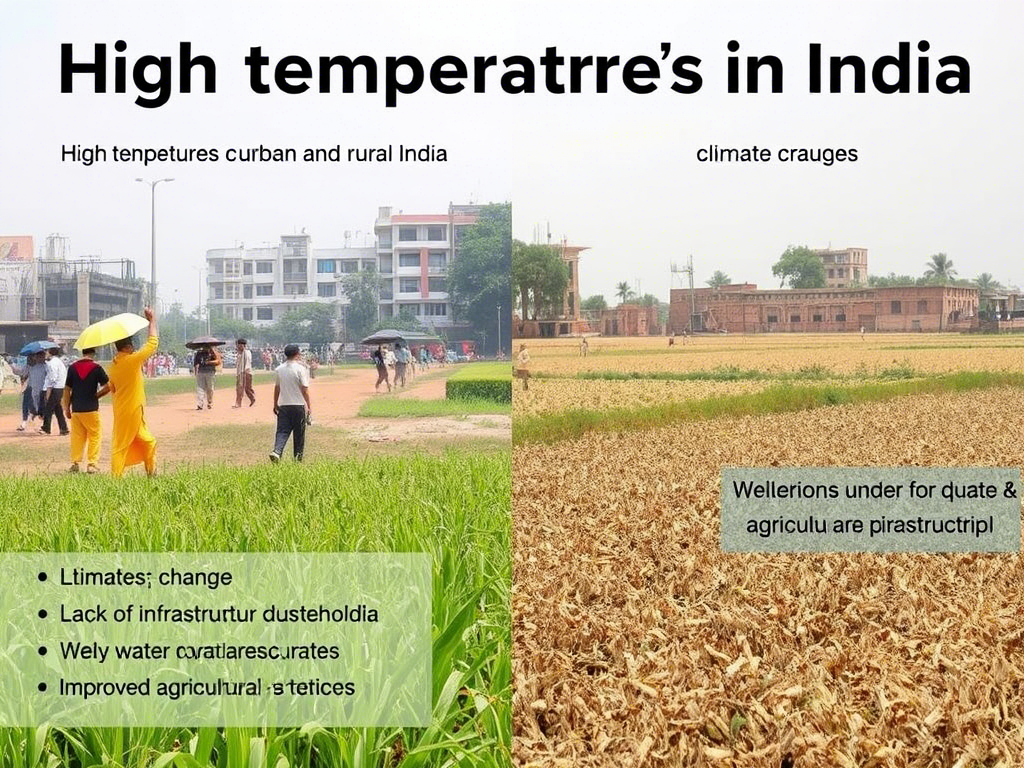Electric Salt and Pepper Grinder Set - Rechargeable Automatic Salt and Pepper Shakers, Kitchen Appliances with External Adjustable Coarseness, Larger Hopper for Cooking, Home Gifts(2 Pack,Black/Black)
$23.74 (as of December 3, 2025 14:48 GMT +00:00 - More infoProduct prices and availability are accurate as of the date/time indicated and are subject to change. Any price and availability information displayed on [relevant Amazon Site(s), as applicable] at the time of purchase will apply to the purchase of this product.)Introduction
India, with its vast population and diverse climate, is increasingly facing the challenges posed by excessive heat. Rising temperatures, prolonged heatwaves, and the urban heat island effect are becoming more frequent, affecting public health, agriculture, and the economy. This article examines the causes of these rising temperatures, their impacts on health and agriculture, and potential strategies to mitigate these challenges.
Causes of Rising Temperatures in India

- Climate Change: Global climate change is a significant driver of rising temperatures in India. The increase in greenhouse gas emissions has led to a general warming trend, with India experiencing more frequent and severe heatwaves.
- El Niño Effect: The El Niño phenomenon often leads to increased temperatures in Asia. This weather pattern disrupts normal monsoon patterns, resulting in less moisture and higher temperatures.
- Urban Heat Island Effect: Rapid urbanization has led to the proliferation of impermeable surfaces and buildings that absorb and retain heat, creating urban heat islands. These areas can be 4-12°C warmer than surrounding rural areas.
- Sparse Pre-Monsoon Showers: Reduced pre-monsoon rainfall leaves large parts of India arid and dry, exacerbating heat conditions.
Health Impacts of Excessive Heat

- Heat-Related Illnesses: High temperatures can cause dehydration, heat cramps, heat exhaustion, and heat stroke. India has seen a 34% rise in heat-related deaths between 2003-2012 and 2013-2022.
- Public Health Crisis: Approximately 90% of Indians are vulnerable to heat-related illnesses, with rural healthcare systems often overburdened.
- Labor Productivity Loss: Heat exposure leads to significant productivity losses, particularly among outdoor workers. In 2021, Indians lost 167.2 billion potential labor hours due to heat exposure, equivalent to about 5.4% of the national GDP.
Agricultural Impacts of Excessive Heat

- Crop Damage and Yield Reduction: High temperatures can damage crops, reduce yields, and even lead to crop failure. This disrupts the supply chain and increases food prices.
- Water Scarcity: Increased irrigation demands and declining groundwater levels threaten agricultural productivity. Only 4% of the world’s freshwater is found in India, while it has 18% of the world’s population.
- Impact on Livestock: Rising temperatures can reduce milk production by up to 25% by 2085 in India’s arid to semi-arid areas. Poultry and fisheries are also affected, leading to higher prices for these products.
Mitigation Strategies

- Government Initiatives:
- The National Disaster Management Authority (NDMA) has developed Heat Action Plans (HAPs) to enhance preparedness and response to heatwaves.
- The National Framework for Heatwave Mitigation and Management (2024) focuses on long-term mitigation, including local vulnerability assessments and community participation.
- Cool Roofs and Green Infrastructure:
- Implementing cool roofs and green roofs can significantly reduce urban temperatures. These measures help lower the need for air conditioning and reduce the urban heat island effect.
- Early Warning Systems:
- Strengthening early warning systems through coordination between the Indian Meteorological Department (IMD) and NDMA can improve preparedness and response.
- Protecting Vulnerable Populations:
- Revising working hours, providing cooling vests for outdoor workers, and establishing cool rooms in high-risk urban areas can protect vulnerable populations.
- Water Conservation Measures:
- Promoting rooftop rainwater harvesting and setting up water kiosks in vulnerable communities can help address water scarcity.
Conclusion

The rising temperatures and heatwaves in India pose significant challenges to public health, agriculture, and the economy. However, through a combination of government initiatives, technological solutions, and community participation, it is possible to mitigate these impacts. Continued efforts to address climate change, improve infrastructure, and enhance public awareness will be crucial in building resilience against excessive heat in India.



